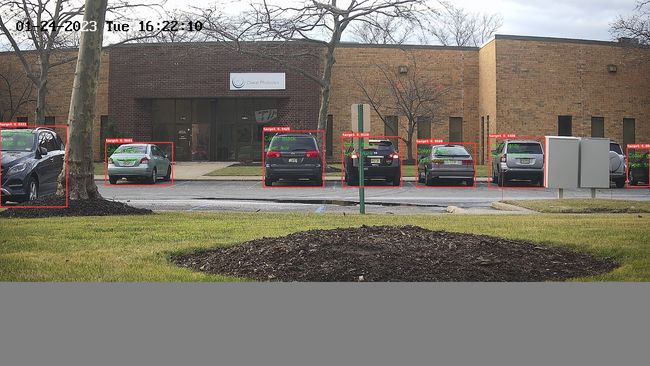PPVehicle车辆属性的识别服务
PPVehicle车辆属性的识别服务
一.功能说明
- 实现web服务,在页面上导入图片,输出车位置、颜色和车型
- 绘制在图片上,并显示
- 支持API接口
- 当前提供的预训练模型支持识别10种车辆颜色及9种车型,同VeRi数据集,具体如下:
# 车辆颜色
- "yellow"
- "orange"
- "green"
- "gray"
- "red"
- "blue"
- "white"
- "golden"
- "brown"
- "black"
# 车型
- "sedan"
- "suv"
- "van"
- "hatchback"
- "mpv"
- "pickup"
- "bus"
- "truck"
- "estate"
二.开发环境搭建
1.搭建conda环境
1.1.下载conda安装包
wget https://mirrors.tuna.tsinghua.edu.cn/anaconda/archive/Anaconda3-2021.11-Linux-x86_64.sh
1.2.执行安装
bash Anaconda3-2021.11-Linux-x86_64.sh
期间Enter直接回车,yes|no选择yes
1.3.安装后添加环境变量
vim ~/.bashrc
文件最后追加下面内容
export PATH="/home/test/anaconda3/bin:$PATH"
加载环境变量
source ~/.bashrc
1.4.查看安装结果
conda --version
如果有版本输出则安装成功
2.搭建项目运行环境
2.1.创建虚拟运行环境
conda create -n pp python=3.7
这里选择工程的python运行版本为3.7
2.2.切换到虚拟运行环境
conda activate pp
2.3.安装python依赖module
依赖module列表
cat >> requestsments.txt << EOF
numpy==1.21.6
tqdm
typeguard
visualdl>=2.2.0
opencv-python <= 4.6.0
PyYAML
shapely
scipy
terminaltables
Cython
pycocotools
setuptools
# for vehicleplate
pyclipper
# for mot
lap
motmetrics
sklearn==0.0
filterpy
# flask
Flask>=2.1.0
paddlepaddle==2.4.1
EOF
2.4.执行安装命令
conda install lap
pip install -r requirements.txt -i https://pypi.douban.com/simple
在安装requirements.txt是会有异常产生,需要依赖lap
三.运行测试code
1.下载工程
git clone https://github.com/PaddlePaddle/PaddleDetection.git
2.测试demo
cd PaddleDetection
# 预测单张图片文件
python deploy/pipeline/pipeline.py --config deploy/pipeline/config/infer_cfg_ppvehicle.yml \
--image_file=test_image.jpg \
--device=gpu
image_file:指定测试文件
四.配置项说明
1.配置文件
配置文件路径
deploy/pipeline/config/infer_cfg_ppvehicle.yml
配置文件中与属性相关的参数如下:
VEHICLE_ATTR:
model_dir: output_inference/vehicle_attribute_infer/ # 车辆属性模型调用路径
batch_size: 8 # 模型预测时的batch_size大小
color_threshold: 0.5 # 颜色属性阈值,需要置信度达到此阈值才会确定具体颜色,否则为'Unknown‘
type_threshold: 0.5 # 车型属性阈值,需要置信度达到此阈值才会确定具体属性,否则为'Unknown‘
enable: False # 是否开启该功能
2.修改模型路径,有以下两种方式:
- 方法一:./deploy/pipeline/config/infer_cfg_ppvehicle.yml下可以配置不同模型路径,属性识别模型修改VEHICLE_ATTR字段下配置
- 方法二:直接在命令行中增加-o,以覆盖配置文件中的默认模型路径:
python deploy/pipeline/pipeline.py --config deploy/pipeline/config/infer_cfg_ppvehicle.yml \
--video_file=test_video.mp4 \
--device=gpu \
-o VEHICLE_ATTR.model_dir=output_inference/vehicle_attribute_infer
五.封装接口
1.调用工程模块,切换运行环境
import os
import sys
#运行环境切换到调用工程目录
PRO_PATH = os.path.join(os.path.abspath(os.path.dirname(__file__)),"PaddleDetection")
ENV_PATH = os.path.join(PRO_PATH,"deploy/pipeline")
sys.path.append(ENV_PATH)
from PaddleDetection.deploy.pipeline.pipeline import argsparser,merge_cfg,print_arguments,Pipeline
2.初始化模型
def init_ppvehicle():
"""初始化车辆属性识别
Returns:
_type_: 车辆属性识别对象
"""
paddle.enable_static()
# parse params from command
parser = argsparser()
# python deploy/pipeline/pipeline.py --config deploy/pipeline/config/infer_cfg_ppvehicle.yml --image_file=./deploy/pipeline/docs/images/ppvehicleplate.jpg --device=gpu
# 输入初始化参数
FLAGS = parser.parse_args([
#测试结果输出到指定目录
'--output_dir','./out',
#配置文件路径
'--config',os.path.join(PRO_PATH,'deploy/pipeline/config/infer_cfg_ppvehicle.yml'),
# 测试图片路径
'--image_file',os.path.join(PRO_PATH,'deploy/pipeline/docs/images/ppvehicleplate.jpg'),
#设置运行gpu:0
'--device','0'
])
FLAGS.device = FLAGS.device.upper()
cfg = merge_cfg(FLAGS) # use command params to update config
print_arguments(cfg)
pipeline = Pipeline(FLAGS, cfg)
return pipeline
3.执行检测识别
def exec_ppvehicle(pipeline,input = None,output = None):
"""车辆属性识别
Args:
pipeline (_type_): 车辆属性识别对象
input (_type_, optional): 输入路径. Defaults to None.
output (_type_, optional): 输出目录. Defaults to None.
Returns:
_type_: _description_
"""
if input:
#输入路径['']
pipeline.input = input
if output:
#修改测试结果输出目录
pipeline.predictor.output_dir = output
# 执行车辆检测识别
pipeline.run()
#返回结果
return pipeline.predictor.pipeline_res.res_dict
4.检测结果解析
def result_ppvehicle(out_path,res_dict,isprit=False):
"""车辆属性识别返回结果解析
Args:
out_path (_type_): 输出图片路径
res_dict (_type_): 识别结果,返回结构化结果
isprit (bool, optional): 特殊格式. Defaults to False.
Returns:
_type_: _description_
"""
out_dict = {}
logging.warning(out_path)
if os.path.exists(out_path):
with open(out_path,"rb") as f:
img = str(base64.b64encode(f.read()),'utf-8')
boxes = res_dict["det"]["boxes"]
vehicle_attrs = res_dict["vehicle_attr"]["output"]
rec_res = []
num = 0
for box,attrs in zip(boxes,vehicle_attrs):
score = box[1]
x1,y1,x2,y2 = box[2:]
if isprit:
rec_res.append([num,",".join(attrs),float(f'{score:.3f}')])
else:
atrr_dict = dict(attr.split(":") for attr in attrs)
atrr_dict["score"] = float(f'{score:.3f}')
atrr_dict["box"]={
"x1":float(f'{x1:.3f}'),
"y1":float(f'{y1:.3f}'),
"x2":float(f'{x2:.3f}'),
"y2":float(f'{y2:.3f}'),
}
rec_res.append(atrr_dict)
num = num + 1
out_dict["dets"] = rec_res
logging.warning(out_dict)
out_dict["image"] = img
return out_dict
六.开发Api,并Postman测试
1.Flask运行接口搭建
# -*- encoding: utf-8 -*-
# @Author: fy
# @Contact: [email protected]
import os
import base64
import json
import time
import logging
from wsgiref.simple_server import make_server
import cv2
import numpy as np
from flask import Flask, render_template, request
from tools import CfgUtil as cfg
from tools.Logger import Logger
from Vehicle import init_ppvehicle,exec_ppvehicle,result_ppvehicle
app = Flask(__name__)
# 调整接收文本大小
app.config['MAX_CONTENT_LENGTH'] = 30 * 1024 * 1024
@app.route('/')
def index():
return render_template('index.html')
@app.route('/api/v1/vehicle/detect', methods=['POST'])
def ocr_idcard():
if request.method == 'POST':
try:
#接收检测图片
json_obj = request.get_json()
logging.warning(json_obj)
img_str = json_obj["image"]
image = base64.b64decode(img_str + '=' * (-len(img_str) % 4))
nparr = np.frombuffer(image, np.uint8)
except Exception as e:
logging.error(e)
return json.dumps({"code": -1001,"msg": u"Incomplete parameters","data": {}})
try:
image = cv2.imdecode(nparr, cv2.IMREAD_COLOR)
if image.ndim == 2:
image = cv2.cvtColor(image, cv2.COLOR_GRAY2BGR)
except Exception as e:
logging.error(e)
return json.dumps({"code": -1101,"msg": u"Detection failed","data": {}})
image = None
out_dict = {}
try:
t1 = time.time()
# 3.执行检测识别
# 4.检测结果解析,格式化输出结果
except Exception as e:
logging.error(e)
return json.dumps({"code": -1102,"msg": u"Parsing failed","data": {}})
logging.warning(f'out_dict:{out_dict}')
return json.dumps({"code": 1000,"msg": "success","data": out_dict})
if __name__ == '__main__':
# 1.初始化模型,创建车辆属性识别对象
# 2.对象第一次执行,可能存在第一次耗时较长的问题
ip = '0.0.0.0'
ip_port = 9999
logging.warning(f"http://{ip}:{ip_port}")
server = make_server(ip, ip_port, app)
server.serve_forever()
2.调用识别封装接口
- 初始化模型,创建车辆属性识别对象
- 对象第一次执行,可能存在第一次耗时较长的问题
- 执行检测识别
- 检测结果解析,格式化输出结果
